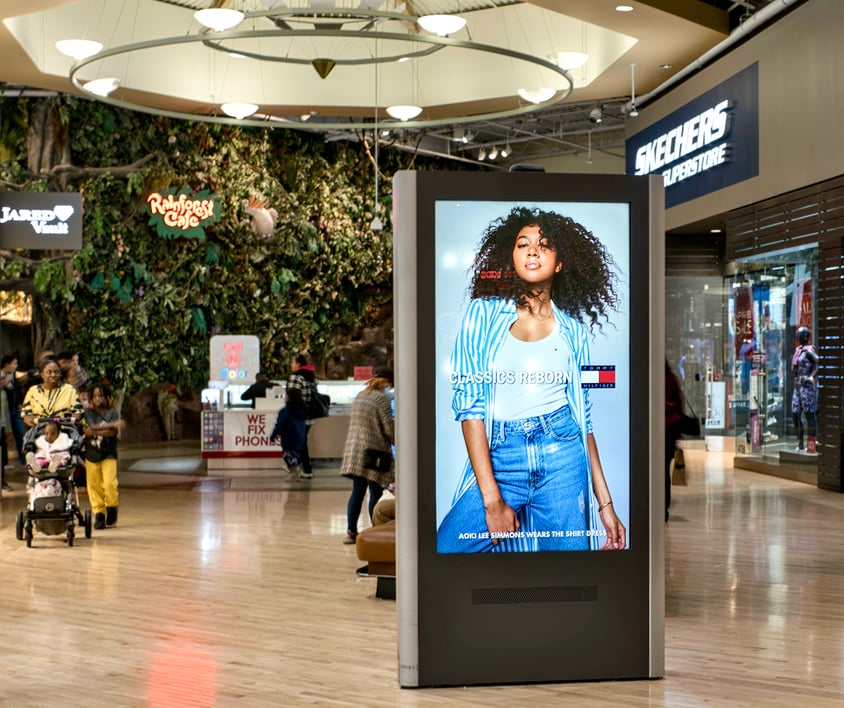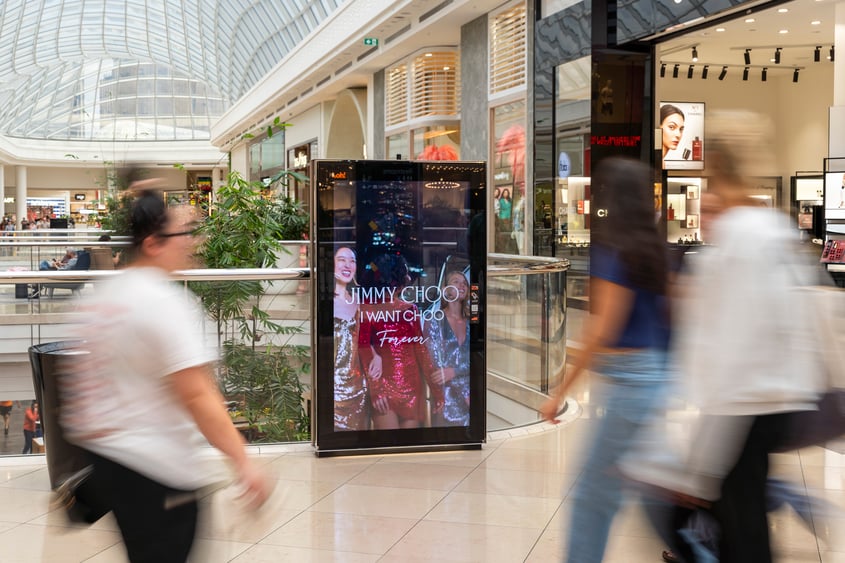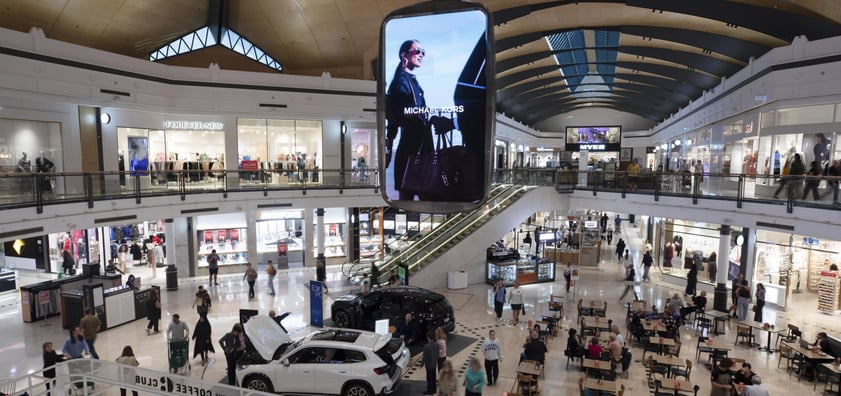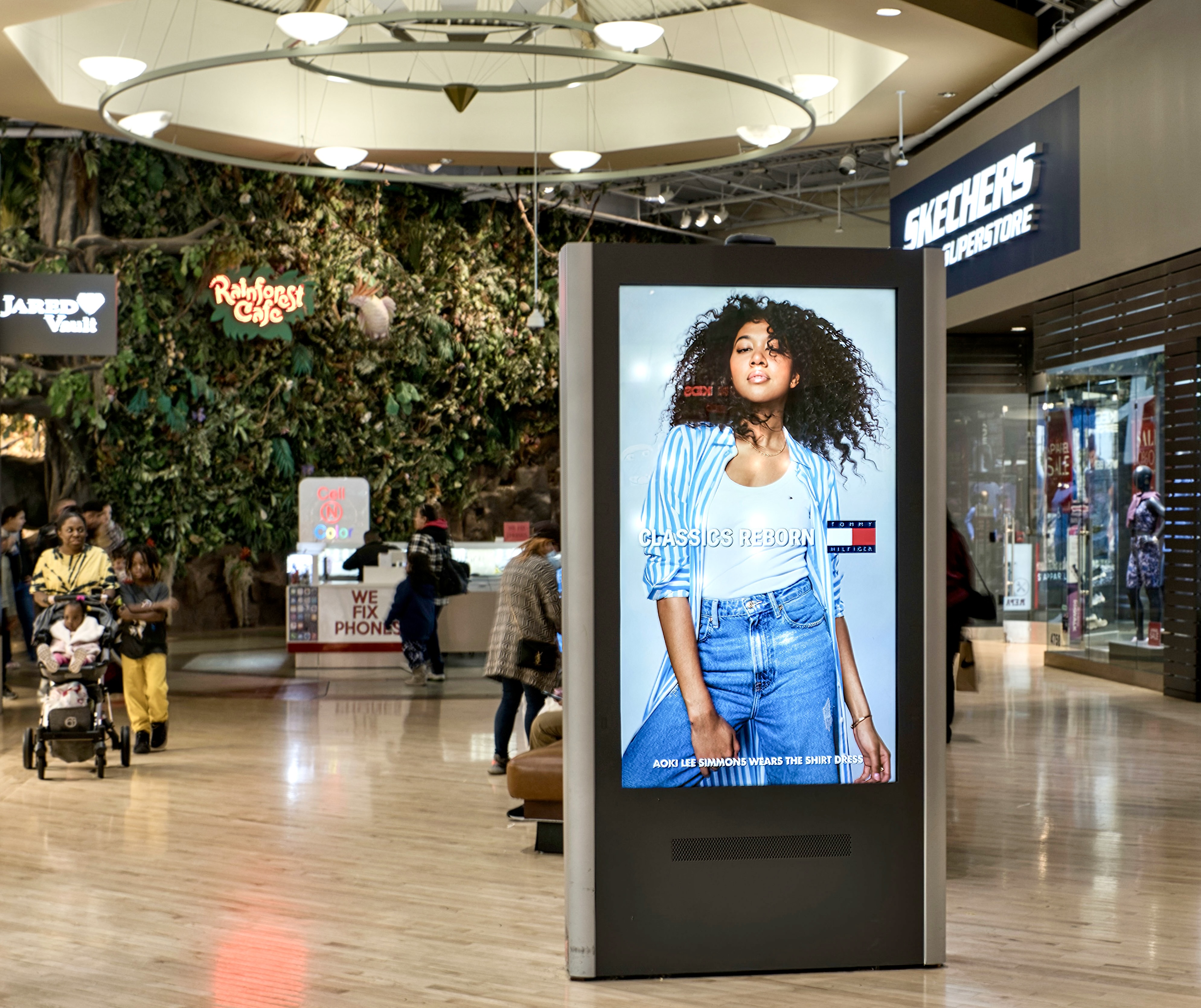In the past, shopping malls were the go-to spot for retail purchases. Before the pandemic, they were starting to feel like a thing of the past, with online shopping on the rise. Today, malls have increased in popularity as audiences combat “screen fatigue.” Modern shopping malls are capitalizing on this. They have shifted gears to provide a more enticing destination experience. Many malls have been undergoing a transition for several years. They are becoming lifestyle centers and community destinations rather than pure shopping venues.
What does this mean for shopping mall advertisers? People are still going to shopping malls and open-air malls. Cinemas, parks, grocery stores, and community events often anchor stores. They have become a place where advertisers can get in touch with local communities, using rich messaging because of the long dwell times. In this article, you will learn all about shopping mall advertising. You’ll learn the benefits, formats available, and best practices.

What are the Benefits of Shopping Mall Advertising?
Shopping Mall advertising has many benefits for advertisers. It is a great tactic to penetrate local communities that may otherwise be hard to get into with OOH. It also reaches audiences who are in a purchasing mindset. Mall advertising works best for brands with products available for purchase right inside the mall. But even when the brand is not an on-site product, it may still make sense to leverage mall advertising. Shopping Mall advertising reaches a priority audience segment: heads of households, families, & children are prominent audiences in most malls. Depending on where the mall is located, it may be relevant to reach an upscale or luxury audience. Here are some of the benefits of Shopping Mall advertising:
- Audience is Already in Buying Mindset: People often go to malls for retail purposes. And you want your brand to be top of mind when making purchase decisions.
- Ensured Attention: Shopping mall advertising has an extended dwell time. You can ensure your ads are seen and fully digested by your audience.
- Ability to Publicize Products and Services Under one Roof: Shopping malls are generally self-contained buildings or areas. This allows you to have a variety of ad placements throughout the venue, boosting frequency and ad recall.
- Maximum Engagement with the Right Placement: Advertisers can create rich contextualized messaging because of their high dwell time and audiences primed to make purchases.
- Hyperlocal Promotion: Now that shopping malls are becoming lifestyle centers, advertisers are becoming more mindful. They recognize people are coming to the mall not just to shop but to be part of the local community.
- Programmatic Options with Omnichannel Insights if in DSP: Programmatic inventory is growing, allowing advertisers to buy space on mall screens in select markets with more flexibility and dynamic functionalities like weather trigger messaging and day-parting.
- Low Minimum Spend Requirements for Small Advertisers: Entry level advertising in a shopping mall is generally not expensive compared to other forms of advertising. It can be an excellent option for smaller brands to break into a market.
- Post-Pandemic Traffic Returning to Malls: Now that the pandemic has lifted, people want to be outside and with others. Screen fatigue has led people to desire real-world shopping experiences vs. doing all of their online retail.
What are the Different Types of Shopping Mall Advertising to Choose From?
There is a wide variety of Shopping Mall advertising formats and units for advertisers. Here are a few of the most popular, but keep in mind that exact formats will vary based on the venue and market:
- Sky Banners: Large banners hanging from the ceiling are hard for audiences to miss when moving through a mall.
- Spectaculars: Eye-catching, large-format printed pieces that demand attention (options exist for both printed and digital placements).
- Elevator/Escalator Wraps: Wraps on elevators and escalators reach your audiences as they move between mall floors.
- Glass Bridges: Signage along walkways catches audiences as they move through the mall.
- Food Court: Food courts sometimes operate a separate digital network from other parts of the mall. They can be an excellent way for advertisers to reach a captivated audience as they sit and eat. Static Food Court signage, like Table Tops, is also available.
- Kiosks: Eye level, static backlit displays provide frequency and directional support.
- Digital Networks and Kiosks: There is a shift to more digital media. Many larger impact formats are changing to digital screens. In some cases, eye-level or overhead digital networks can cover the entire mall!
- Standees: Static standees in front of stores can help advertise brands sold within that store. They can also provide custom directional signage towards a specific store in another part of the mall.
- Cinema: Advertising near and within the movie theater can capture audiences' attention when they are on their way to see a show or in a captive theater environment before their movie begins.
- Event Spaces: Advertisers can execute custom activations by working with the mall to pay for a footprint on the property. These activations often need brand and creative concept approval from the property. Third parties must typically provide staffing, produce branded items, and plan/execute the activation. Custom Brand Events are often more costly than other forms of Shopping Mall Advertising. But they can provide a unique and memorable brand experience.
- Event Sponsorships: Advertisers can also sponsor existing events. For example, a company could sponsor and align its brand with a Meet Santa event. This kind of advertising builds upon the excitement of other events to create a halo effect.
You will not have a total Share of Voice (SOV) for digital mall advertising. In most cases, your ad will run on rotation with other advertisers in the loop. Most malls and lifestyle centers have been converting to digital format offerings in major metro areas. In some malls with higher demand, there are opportunities to buy ad space to cover the entire mall on a single digital network. In more rural areas with less demand, you will likely need to leverage static or printed formats to cover the mall adequately.

How Much Does it Cost to Advertise in a Shopping Mall?
Shopping Mall advertising costs vary greatly depending on the format, market, and campaign length. Some options work well for those looking to break into outdoor advertising at a lower rate. But some formats can be quite costly (especially when planning for a more premium and upscale venue with higher demand).
Another consideration in Shopping Mall Advertising costs is seasonality. More people shop around the holidays and in the 4th quarter of the year. This results in higher foot traffic at these times. There is also more competition for advertising. Most shopping malls have higher rates around holiday shopping times (November-December). Advertisers will want to plan their campaigns further in advance to ensure the best inventory is available.
Are Shopping Mall Advertisements Right for My Business?
Is Shopping Mall advertising right for your business? Shopping mall advertising works well for a variety of advertisers. It makes the most sense for retail clients that are on-premise. It puts their store top of mind. It is also a great place to advertise if your brand wants to reach locals and families. Depending on the mall type and the market, malls and lifestyle centers can also be great places for upscale and luxury brands to advertise. Every mall has its own audience and demographic profile that it serves.
While Shopping Mall Advertising works for many businesses, the advertiser may want to consider placements carefully. For example, an upscale brand in a rural market mall may wish to avoid being in a parking garage or food court. They will likely want to be on high-impact placements such as a spectacular or sky banner to maintain brand positioning. However, if an upscale brand plans a lifestyle center campaign with VIP / Valet Parking advertising available, this could be a perfect fit to reach their high net-worth audience right when they arrive.

Best Practices in Shopping Mall Advertising
Shopping Mall Advertisers should know their audience and how to reach them through their advertising best. Here are some best practices that will help ensure successful Shopping Mall advertising campaigns:
- Plan early for peak holiday times.
- Know your audience and the audience profile of the mall. Malls can sometimes provide statistics on the make-up of their audiences. However, these stats are not as defined as other OOH and rely on foot traffic reporting from the venue. They often only provide monthly average circulation numbers (not Geopath Audited Impressions). Leveraging other data sources, such as ESRI, can help understand the demographics in the surrounding areas and determine a mall audience’s profile.
- Don’t pigeonhole yourself. It’s good to have coverage in different parts of the mall. Kiosk-type networks offer full coverage through hall entrances and exits. Or you could use a Sky Banner in the hub of the mall. Ideally, you would have coverage on multiple wings to make sure everyone has the chance to see your ad.
- Be aware of your brand. If you are a luxury brand, then you likely won’t want to be in a mall that has stores like Macy’s and Dicks Sporting Goods. However you may benefit from advertising there, if other luxury brands are available in that mall.
- Buy longer campaigns for discounts. Typically, campaigns are bought monthly, but if they are bought more long-term, there’s a higher potential for discounted rates.
- Be aware of your market and the specific mall. Depending on what specific mall you choose to advertise in, different media options and varied rate structures will be attached.
A Single Stop Shop for OOH Planning and Measurement
Billups has 20 years of experience planning, buying, and reporting OOH campaigns. Our experienced specialists have deep knowledge of the markets they serve. Work with Billups to make your outdoor advertising experience a turnkey event. Reach out today.



